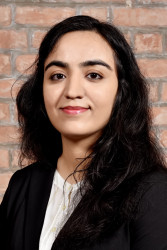Live Project - Gen-AI powered Knowledge Management System for IIMA | BCG X
- Developed a Knowledge Management System platform as a part of 3 member team using Large Language Models (LLMs) to assist students and administration at IIMA
- Analyzed Llama models and leveraged their APIs to develop a working prototype, including setting up a data ingestion pipeline and a vector database
Independent Research Project - Digital Healthcare Records, Interoperability and AI Analytics | CIIE
- Landscaped the HealthTech space to identify key business opportunities in implementation of Digital Healthcare Records, Interoperability, and AI Analytics, needed to drive digital healthcare transformation in India
- Developed a business model that incentivizes the adoption of digital health records among Indian users and ensures the system's long-term sustainability
Advisory Software Engineer | IBM Watson | New York City, NY, USA
- Spearheaded the development of a high-performance event streaming consumer microservice using Apache Kafka for real-time data ingestion from third-party services. This solution improved data flow and boosted user engagement with the Watson Assistant platform by 10%
- Spearheaded the development of a web application integrating Watson Assistant with Salesforce and played a key role in developing integrations for other platforms like Slack, Facebook, and Zendesk as well. This initiative played a crucial role in acquiring about 2x new customers
- Proposed and implemented advanced authentication mechanisms, including OAuth 2.0, for integrating third-party services with Watson Assistant, by drawing on industry best practices from HubSpot, Zoho, and Slack. Also optimized UI/UX design to incorporate these changes
- Conceptualized and implemented a new routing framework that efficiently directed Watson Assistant users to the appropriate human agents, involving modifications to the UI/UX design to significantly enhance user navigation and support
- Led the development of a tool that improved intent (or topic) classification accuracy within Watson Assistant by 12% through the incorporation of human-annotated data, significantly improving the mapping of user utterances to relevant topics
- Engineered and optimized algorithms for extracting system entities (e.g., currency, dates) from user utterances, achieving about 10% boost in System Entity Recognition accuracy
- Actively contributed to Watson’s open-source community by developing a tool that enabled users to customize their data models for the Speech to Text Service, which increased developer engagement and expanded the service's user base by 2x
- Engaged directly with clients to identify and resolve pain points, utilizing Agile methodologies and tools like Jira and Asana to track and manage production issues. Authored technical blogs on newly released features to enhance community knowledge
- Worked with different languages and technologies including Java, Node.js, Typescript, Python, Docker, Apache Kafka, Nginx, Akamai, IBM Cloud, Redis, SQL
Software Engineer | IBM Watson | New York, NY, USA
- Led the development of algorithms for extracting data from various documents, including PDFs, scanned PDFs, images, and MS Word files, by leveraging advanced image processing techniques and data extraction libraries such as OpenCV. This new feature helped in acquiring about 3x new customers
Research Assistant | New York University (NYU)| New York City, NY, USA
- Conducted research under the guidance of Prof. Yao Wang and Prof. Li Feng in medical image processing and deep learning. The goal was to detect long COVID patients using dynamic lung MRIs. Additionally, developed automated histogram analysis using self-supervised learning for organ segmentation, demonstrated through liver T1 mapping in quantitative MRI. These projects were presented at ISMRM Annual Meeting 2024, Singapore and i2i Workshop 2023, CAI2R, NYU Grossman School of Medicine, New York, NY
- Conducted research under Prof. Grace Lindsay in neuroscience and machine learning, utilizing deep learning models like VGGish to investigate auditory attention, drawing inspiration from previous studies that used vision models such as VGG16 to explore visual attention

